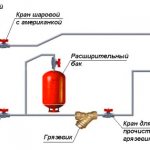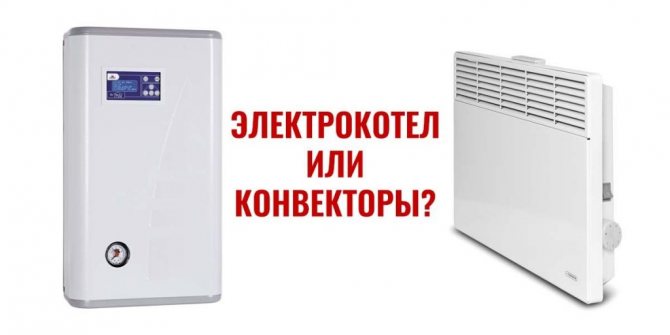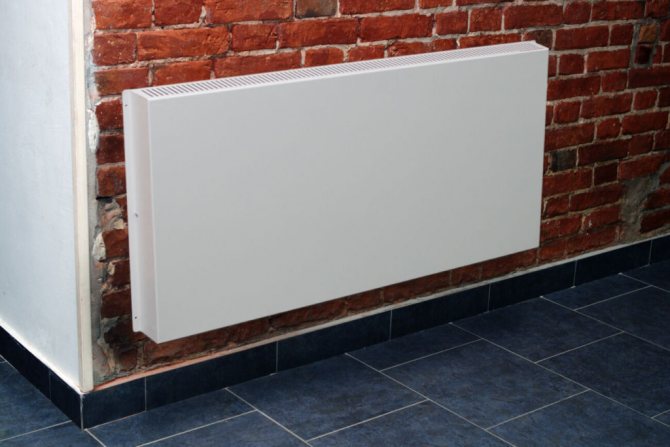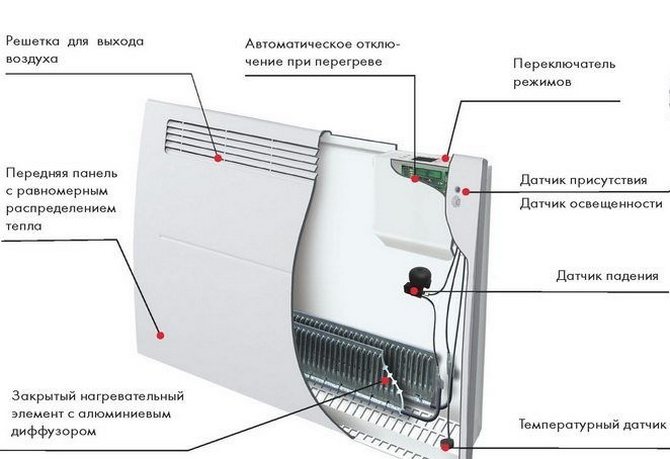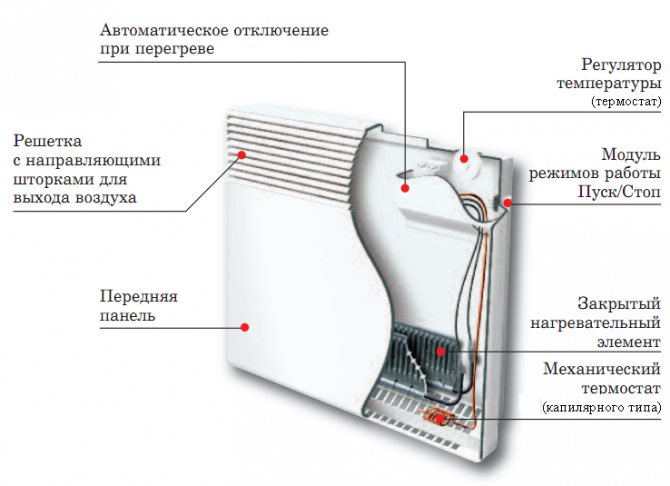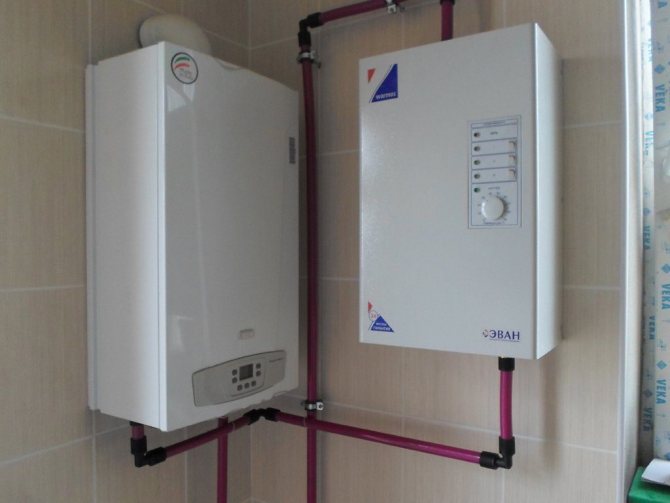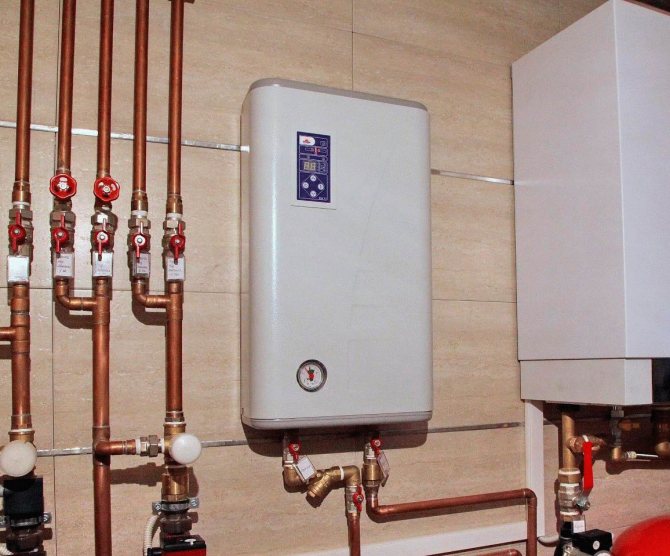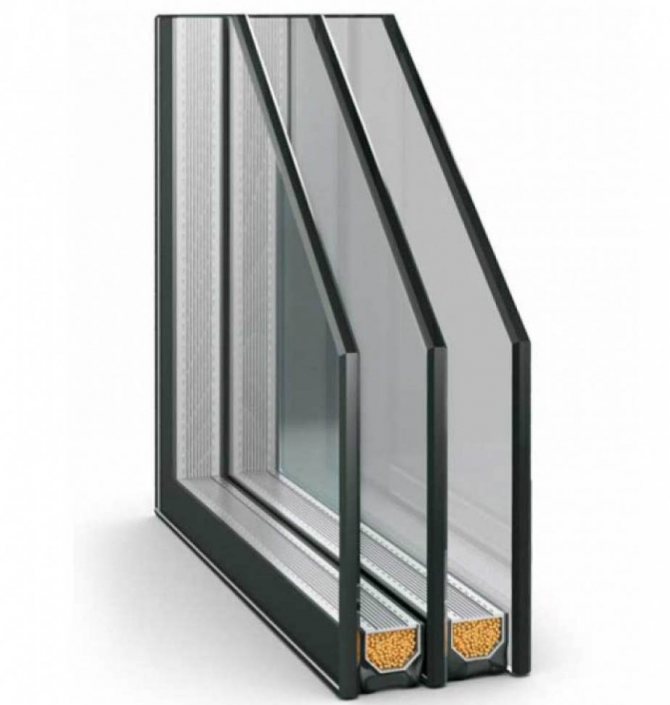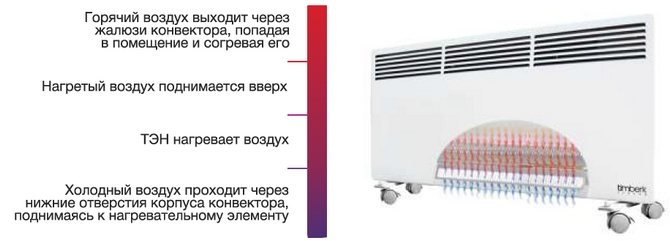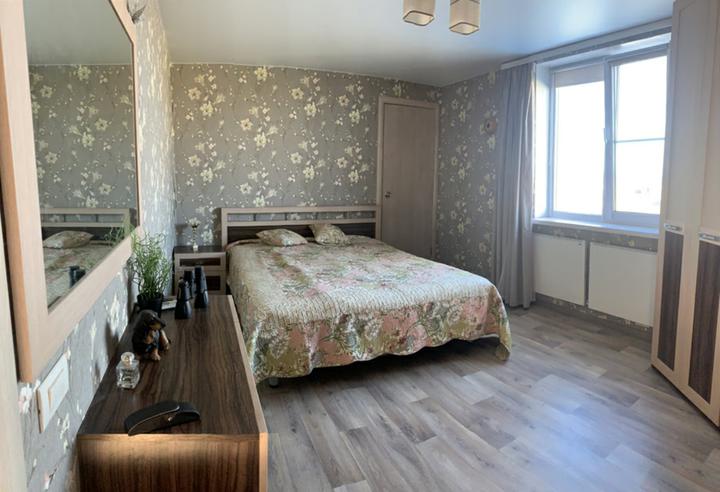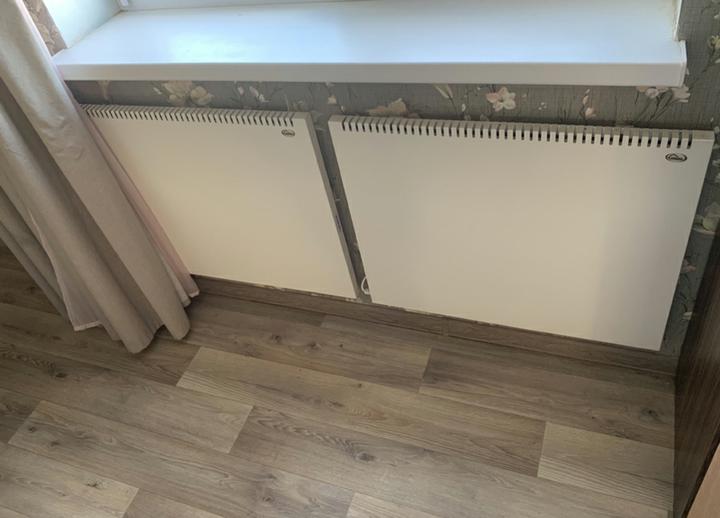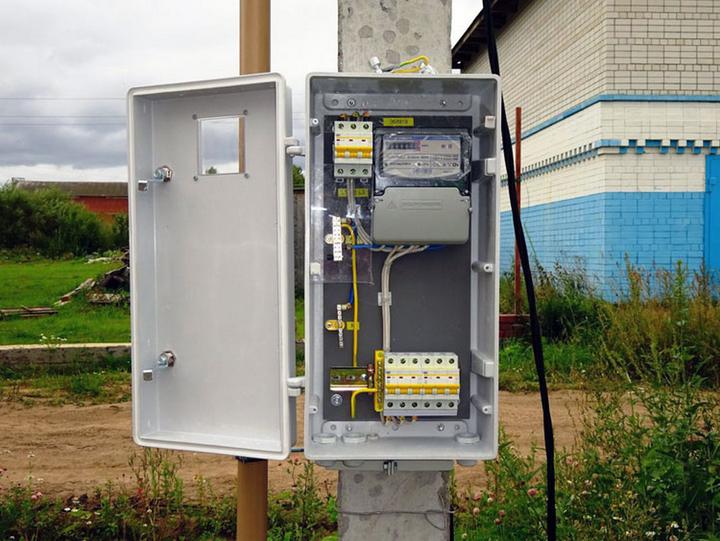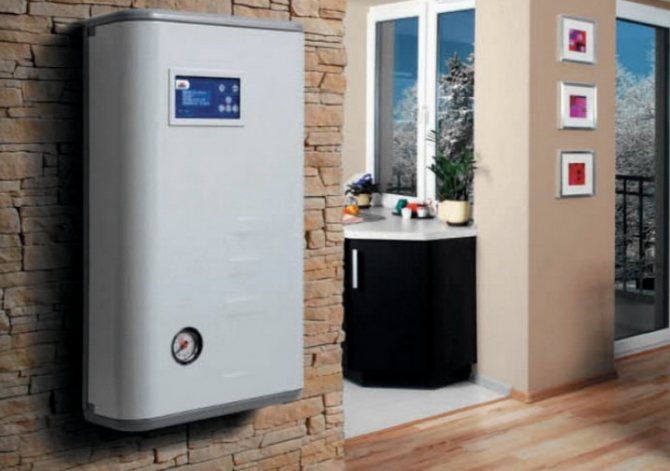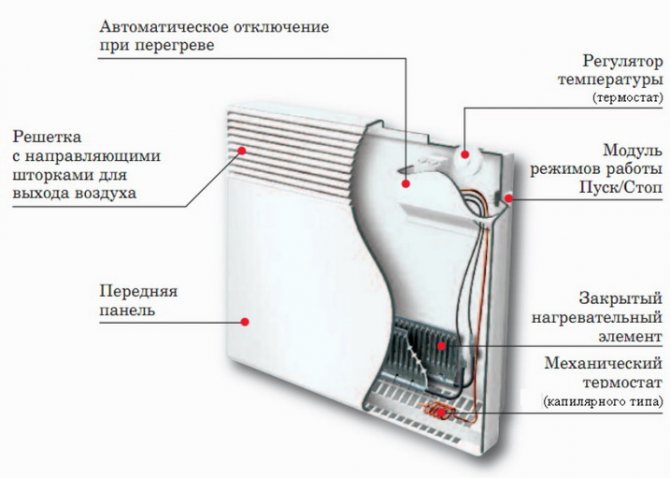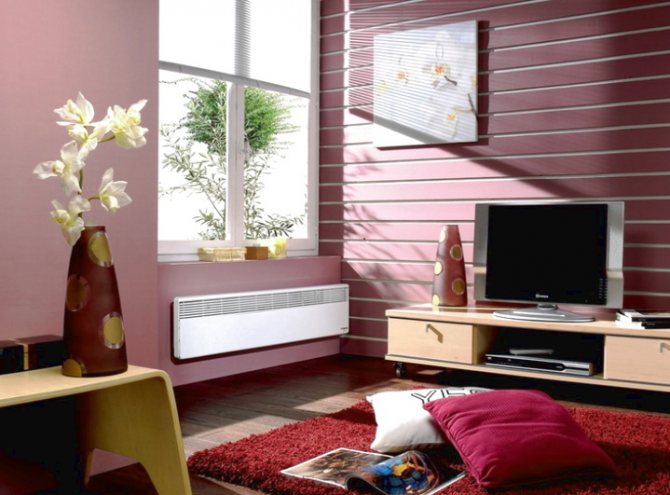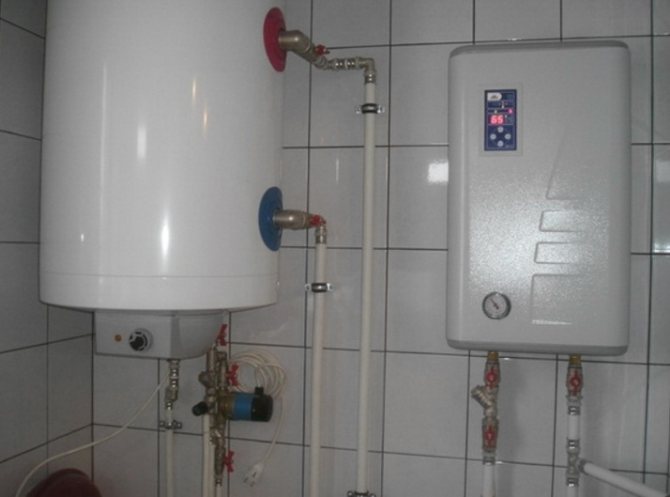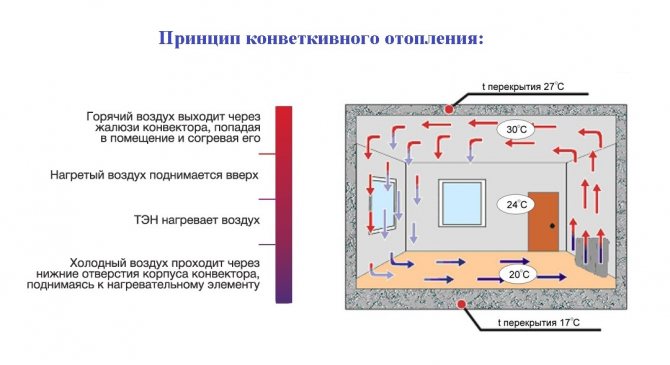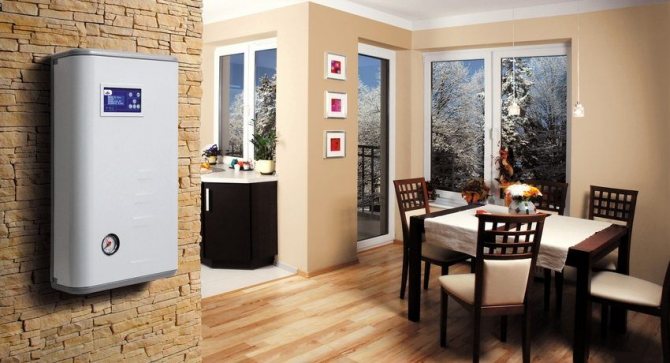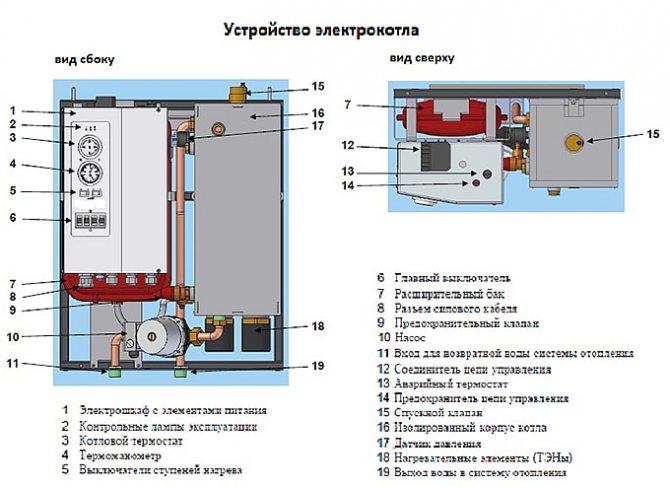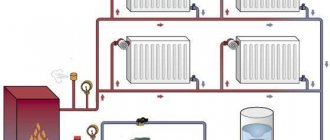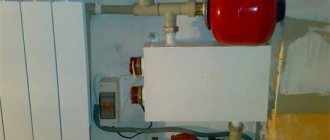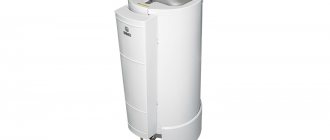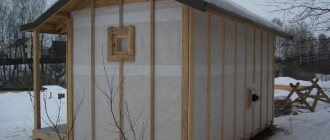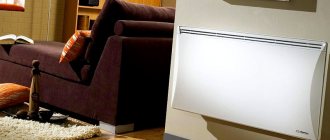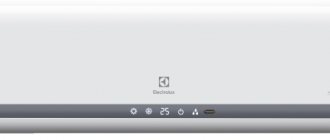Home / Electric boilers
Back to
Published: 30.05.2019
Reading time: 4 minutes
0
482
Before the user, when determining the method of heating his home, where it is not possible to conduct gas, there is a choice of which equipment to use: an electric boiler or a convector.
What is better to choose, because electric boilers and convectors are in demand almost equally. There are several factors to consider here. Each equipment has its own advantages and disadvantages. Let's consider in detail the heating means.
- 1 What is an electric convector
- 2 Pros and cons of convectors
- 3 Heating method 3.1 Boiler
- 3.2 Convector
Why an electric boiler can be cost effective
Many people say that electric boilers should not be installed in any home. After all, the installation of the boiler will be more expensive, and more effort will be required, however, this is not at all the case. Electric boilers began to be used to heat houses in order to save money. But the fact is that if there are few heating devices in the house, the economic efficiency from this method is invisible. But when there are a lot of devices, the savings become significant. However, it will not be visible to the naked eye, this economy must be definitely explained.
Often, people in their decision are based on only two facts: a boiler is much more expensive than several convectors, and the efficiency of these two options is approximately the same. It is about 98-99%. In this case, it turns out that it is much better to install cheaper convectors if their efficiency is the same as that of the boiler. In order to understand where the economic benefit from the boiler comes from, it is necessary to resort to a mechanistic formula, which sounds like this: lowering the air temperature in the room by 1 degree leads to energy savings by 6%. In simple words, this formula says that if the air is overheated by only 3 degrees, then 18% of the energy carrier is lost, hence the economic efficiency of the electric boiler in comparison with electric convectors.
The fact is that in the boiler you can set the power that will cover the heat loss at home for the air temperature that is now on the street. Consequently, the air in the room will not overheat and the boiler will spend exactly as much energy as is needed in order to ensure heat loss at home. But in convectors there is no way to set their power. Regulators on them allow you to set only the desired temperature in a given room. That is, regardless of the temperature you set, it will always work at its full capacity. And the convector will turn off only when the air is already overheated. After all, he sees a difference in air temperature only more than 2 degrees.
Thus, every time the air is heated, a certain amount of kilowatts will be lost, which were spent on overheating the air. Of course, from one time loss is very small and even insignificant. However, this will happen every time the room is heated. And if you have a large house with more than 6 electric convectors installed, you will definitely feel these losses. However, this is not the only plus of the electric boiler. Thanks to the presence of a buffer tank, the boiler can be charged at night at a cheap rate. Ari this day he will not waste electricity at all. And convectors do not have such an opportunity.During the heating of the air, they must be connected to the power supply.
And the third positive distinguishing feature of the boiler is that it can be integrated into the hydraulic system, that is, it can be used for combined heating together with a wood-burning stove, this is also done to save energy.
To summarize all of the above, it can be noted that there are only three points that indicate that it is better to put an electric boiler in a private house for heating than electric convectors:
- the boiler does not waste extra energy by overheating the air
- the boiler can store energy at night at a cheap rate and run on this energy all day
- the boiler can be used quite simply in a combined heating method
Heating with electric boilers
Many people deliberately choose to heat residential buildings with electric boilers, to which hot water heating systems are connected. That is, pipes are laid in the premises, suitable batteries are installed, a coolant is poured into them. An electric boiler is chosen as a heat source - it is the heart of the entire system, providing the batteries with a hot coolant.
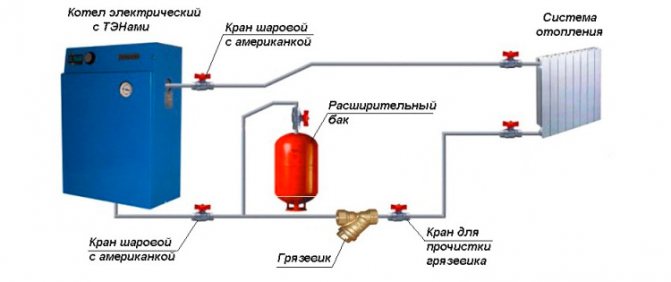
Heating system based on an electric boiler.
Such a scheme is really very simple, and the equipment sold in stores allows you to quickly and easily create a heating system for households of any size, be it a small country house or a chic country two-story cottage. The main thing here is to choose a good electric boiler that will generate heat. Boilers of any format are on sale:
- The simplest ones include a heating element and starting equipment;
- More advanced - with temperature tracking units;
- The most advanced ones are remote controlled.
The cost of the simplest low-power boiler is 3-4 thousand rubles... Thanks to this, consumers can count on low costs for creating a heating system.
There is one more division of electric boilers - according to the principle of heating the coolant:
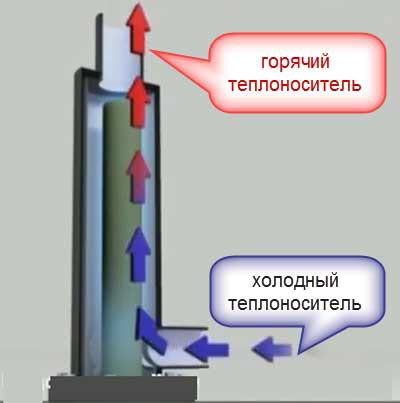
The scheme of movement of the coolant in the electrode heating boiler.
- Heating elements - tubular heating elements are installed here, which provide heating of the water circulating through the system. Their disadvantage is that the heating elements are distinguished by their fragility. They often fail, and the most unpleasant phenomenon is an electrical breakdown to the heating system;
- Electrode - differ in their speed. They are equipped with electrodes that are immersed directly into the coolant. This scheme provides quick warm-up. The main advantage of such electric boilers is high fire safety, since in the absence of a coolant, they are automatically turned off;
- Induction - expensive, but efficient electric boilers. They do not form scale, they also do not have direct contact between live parts and water in the heating system, which significantly increases the level of safety. Disadvantages - high cost and increased complexity, which affects the reliability of the equipment.
As for batteries, steel or aluminum samples are most often used in electric heating systems with electric boilers. Cast iron radiators are hopelessly outdated, they require a large volume of water and have a gigantic weight, which makes them difficult to install.
Considering the question of which is better, an electric boiler or convectors, we will try to consider the principle of operation of electric water heating and identify its advantages and disadvantages. The working principle is very simple - an electric boiler heats up the coolant circulating through pipes and batteries. Through these same batteries, heat passes into the premises. Moreover, the temperature in the rooms rises quite quickly.
The main advantages of water systems with electric boilers:
- Familiar control scheme - there is only one regulator in the system, with which the degree of heating is set;
- Quick start - just turn on the electric boiler, and it will immediately start working;
- Safety - gas fuel is not used here, which ensures explosion safety;
- There is no need to create fuel reserves, as is done when using solid fuel and liquid heating boilers;
- Readiness for a quick conversion to a gas boiler - it is quite possible that soon gas will appear in the current settlement, which can reduce heating costs.
Among the shortcomings was the laboriousness of the installation work. It is necessary to lay pipes throughout the house, lay them through the walls, place and fix radiators, ensure a high-quality connection of all elements in order to avoid leaks. Other disadvantages:
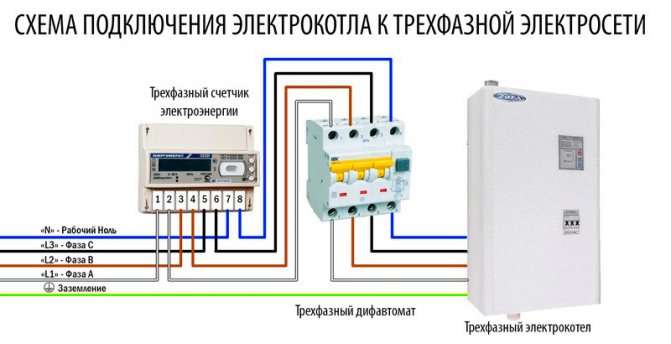

Please note that powerful electric boilers must be connected to a three-pin power supply, which is not always possible.
- An electric boiler needs a robust power grid to operate... For the most powerful boiler, a three-phase network is required at all, which is not always possible in the private sector;
- Contact between electrical equipment and water is in itself unsafe;
- During the operation of the electric boiler, scale can form in it, which reduces the heating efficiency, leading to wasted energy consumption;
- The more coolant in the system, the higher the heating costs;
- For separate regulation of the temperature in the rooms, you will have to create a two-pipe system or lay pipes according to the "Leningrad" scheme;
- Extremely high heating costs - whatever you say, electric heating remains very expensive.
Some disadvantages are quite critical, but you have to put up with them.
In the dispute about which is better, a boiler or a convector, there is always a common drawback - it is the high cost of electric heating. See for yourself - to warm up a house with an area of 100 sq. m. you need 240 kWh of electricity per day. Calculate according to your tariff and look at the total amount.
To reduce heating costs using electric boilers, the following actions are performed - boilers with precise automation are purchased that monitor the temperature in the system and in the premises (and with an accuracy of a degree), or measures are taken to create additional thermal insulation for households. For example, here you can additionally insulate the walls, insulate the attic and install triple-glazed windows.
Difficulties in installing and using electric convectors
- Increased total power of electric convectors. Due to the fact that the power is selected for each individual room, there is always a loss of about 2-4 kilowatts. When all the convectors are turned on at their full capacity, in addition, other electrical appliances are working in the house, this can lead to knocking out the introductory machine. And you can fight this only by turning off the convectors in individual rooms manually, which is too troublesome.
- Electrical network. Due to the fact that the convector is a powerful electrical device, moreover, it works without stopping for at least 5 hours, a separate cable must be installed for it. That is, you cannot turn on the electric convector into any outlet that is in the house.
- It is difficult to control convectors remotely. It is quite possible to do this, but for this it will be necessary to combine all the devices into one network, and then connect them to some executive device that will receive commands from you. This will require additional cash costs.
It turns out that buying an electric boiler and installing electric convectors correctly will cost you about the same amount. The cost of an electric boiler during installation will be slightly higher, but it will pay off in the first year of its use.
What happens during work
Minus 28 degrees, the coldest time we have for the entire heating season.When the temperature is lower, we can set the power in the boiler, which will cover the heat loss at home, for a given temperature outside, i.e. we will not overload the premises. When it is minus 28 degrees outside, we set the boiler power to 14 kW, when minus 10, we set 6 kW, on these kilowatts, the boiler will heat the coolant exactly as much as is required to ensure heat loss at home.
The regulator on the convector is designed in such a way that it can only regulate the air temperature in this particular room, but it cannot regulate the power of the electric convectors, therefore, when the convector turns on, it gives out all its 2 kilowatts, and if our room loses at minus 10 500 watts, then 2 kilowatts overheat the air very quickly. The convector will turn on only when it sees that the air has warmed up enough. This means that it will already be overheated by 2 degrees, but these 2 degrees of overheating will lead to the fact that we will lose energy, giving off excess heat to the street.
In addition, the electric boiler can be integrated with a silo. Since we have a hydraulic system and we will charge this buffer tank at a cheap night rate so that the boiler does not turn on at all during the day. In an electric convector, we cannot stock up on power at night in any way.
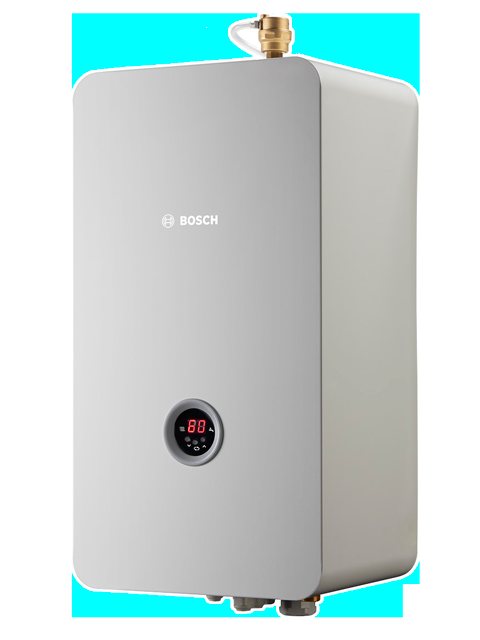

Bosch electric boiler
And the third feature, which is allowed when using an electric boiler, and is impossible when using electric convectors - very often people choose combined heating systems, an electric boiler and a wood-burning, electric one for convenience, wood-burning in order to be heated cheaper. During the day it is heated with wood, at night the electric boiler is turned on at an inexpensive tariff. We cannot integrate electric convectors in any way into a hydraulic system where we have a wood-fired boiler.
Three reasons that lead to the fact that an electric boiler is more attractive to use in a private house than separate electric convectors. In addition, there are technical difficulties that accompany the use of convectors.
There are three such technical difficulties:
- The most unpleasant thing is the increased total power of the electric convectors. Since we select convectors not for the heat loss of the whole house as a whole, but for the heat loss of each individual room, as a result, we get an excess of the required power by at least 24 kW, where to put them and what to provide is not known, because we do not have the power allowed is limitless, we have problems with the introductory machine. When we turn on all the convectors at the power that we do not need, but we cannot adjust it, make it less, plus we have washing machines, a kettle, a TV set, an introductory machine can knock out. There is only one way to deal with this, to walk and turn off certain rooms from the heating, but this is not convenient, because it is cold there and it is necessary to control so that they do not freeze completely and on the verge of freezing it will be necessary to come and turn on the heating in this room again. These are big troubles, somewhere, we will definitely miss something, it is not possible to keep track of everything.
- Electrical network. Anyone who believes that by hanging convectors around the house and plugging them into the nearest outlet, you have done everything that is required, is deeply mistaken. If you are recording powerful electrical appliances that will work for 5-6 hours, please, bring a separate cable to each individual convector, because if you have a line on which additional electrical appliances will hang there will be connections, connections that are in for a long time, they experience a high load, they may start to warm up and no one will give a guarantee that everything is done there with high quality or that something has not oxidized over time. There is a high probability of wire burnout, and subsequently - a fire.
- The last difficulty is the inability to control the convectors remotely, since we can control the electric boiler via SMS. It is possible to control more precisely, but for this all convectors need to be united into a single network, connected to a device that will receive our remote commands.The electric boiler already has it all. Therefore, in terms of cost, electric convectors are similar to radiators and an electrical network that we will need to bring to each convector. The electric boiler will be comparable in price to a smart home that controls a network of electric convectors. From the point of view of initial costs, convectors only benefit if they are simply plugged into sockets. In all other cases, the price of convectors and a boiler with a hydraulic network is approximately the same. The boiler is a little more expensive, but its imaginary high cost, pays off in the very first year of operation according to the three features that we described above.
For which house is it more profitable to use convectors
Heating with convectors implies the installation of a separate heating device in each room. It is impossible to heat two or more rooms with one convector at the same time.
If the house is small and has no more than four rooms, then four heating devices will also be required to create comfortable conditions in it, if there are two rooms in the house, then two electrical devices are enough.
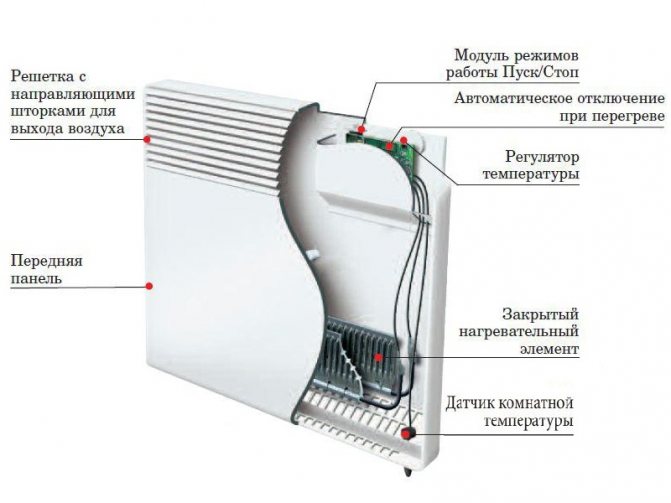

If we are talking about a building with a large number of rooms, it is more profitable to install a heating boiler. It is believed that a house, for which you need 4 convectors, can be heated using these devices, but if you need 6 or more convectors, then it is more economical to install a heating boiler.
This ratio was not chosen by chance. The fact is that during operation, a heating boiler allows you to heat a house at a lower cost compared to convectors. It's just that with a small number of heating appliances, this benefit is invisible, but with an increase in appliances, it becomes more tangible.
Electric convectors for the heating system
Convectors are electric batteries in which air heats up naturally by passing through a heating element. It is enough to fix such a battery on the wall and plug it into a power outlet.
The convector control system is located directly on its body. And the air heating elements are hidden inside. First, the air in the immediate vicinity of the convector is heated, and then the rest. The warm one goes up, the cold one goes down and enters the convector. The buttons of the electric convectors will allow you to set the desired temperature or set the operating mode of the battery. For example, "anti-freeze".
According to the principle of control organization, convectors are divided into mechanical and electronic. The first ones have a pair of "wheels" on the body, which can be twisted to "add" or "subtract" the temperature. And the latter are allowed to control the heating level up to 1-2 degrees.
There is a prejudice that heating with convectors is too expensive. But in fact, it turns out that with the same quadrature, electric heaters are 5-10% more economical.
Of the other advantages of electric convectors, we note:
- Extremely simple installation. No pipes or wires. You simply mount the electric battery to the wall and plug it into the mains. If necessary, you can remove the convector without disturbing the appearance of the room.
- There is no likelihood of a pipe with water or a heating element breaking through, since they simply are not on the convectors.
- Each convector can be adjusted to its own temperature regime. The bedroom can be made warmer. And the living room is a little cooler.
- The back wall of such a battery hardly heats up. All ventilation openings are at the front. You can mount the convector very close to the wall without fear of fire.
- Electric convectors are suitable even for a nursery. The battery heats up but does not burn when touched.
- Convectors are safe for the environment and health. They do not oxidize the air and do not emit harmful impurities.
Cons:
- Electricity consumption will become the main cost item for convector maintenance.
- The time it takes to completely warm up the room depends on the area. To make the room warm up faster, close the door.
However, despite all this, electric convectors are breaking records of popularity among owners of country cottages and houses.
Best Answers
Boss Heat:
The store said correctly if the ceiling height is 3m. Electric convectors are the cheapest option in terms of equipment and installation costs. And you will pay for electricity from the money saved on equipment. You can increase the economy and comfort by connecting one convector through a room thermostat by air. The cheapest electric convectors are Chinese or joint production, cheap does not mean bad
Pay attention to the configuration of the heating element in the convector, if it is tubular with a screw tape around the tube (DELSOT) - it will be heard at night, as it clicks when cooling, heating. If we take more expensive convectors - Siemens, Atlantik, Nobo, then a thermostat in the air is built in them and they do not click
Installing convectors under windows, do not block curtains, do not dry things on them, do not block the air flow from above, that is, observe fire safety. Infrared lamps can be placed where there are no people and high ceilings. It is not comfortable under it. Particular attention is paid to the safety of electrical wiring.
Pavel Melnikov:
I heat it, sometimes it’s -30 outside the window I open the window in one room, I went too far, but I’m quite satisfied.
spiny hedgehog:
how much will you pay for electricity ????
& B:
In such frosts, a lot of energy will burn. Four kilowatts without switching off, Ten kilowatts per day. Heating is real if the same money as for firewood is spent on electricity. .But, in my opinion, it will be more expensive. Fan heaters heat well.
Sergunok:
depending on what permissible power (input machine) and in general in what state the wiring
Pie with kittens !:
did not come across ... on the contrary, I think why I took off the air conditioner for the winter - in a room below +30 only with an open balcony !!!! - they are drowning !!!!
Alexandra:
During the period when it is cold outside the window, and the heating is not turned on, I use a convector. It is very convenient, you turn it on at 22 degrees and this temperature is kept constantly. My relatives heat the house in the village. 1.5 kW at 18m.
Foolish number one and a half:
Infrared are demanding on dimensions - ceiling height, distances from the ceiling and walls. If the ceilings are low, they will be reachable, and the temperature is high, someone removing the sweater may burn themselves. It is inconvenient to use them for such housing. Better convectors. The calculation indicated is applicable.
Konstantin Lozhkin:
Infrared in the house as the main heating is insanity, constant headache is provided. Convectors are good because they are inexpensive, easy to install and quite reliable. Of course, they said correctly about the selection of power, but with a ceiling height of no more than 2.8 meters and good thermal insulation. In general, I put a nobo in my house, divided it into 2 groups. Each group has its own thermostat. It is expensive to be heated purely on electricity, so I still heat the stove in the cold.
Yuri Dubov:
Dmitriy! If you can survive the winter in the same mode, try to survive, in the spring and summer, plan to insulate the house, look at the technologies for pasting with foam, etc., there is a lot of interesting things, but only then do the heating. These works do not require special qualifications, but only then do the heating. I would recommend a combined heating system
Pay attention to electric boilers "beril", but first of all, eliminate the heat loss as much as possible, the costs will pay off
Artyom Shlentov:
For everyone who is interested, I suggest that you familiarize yourself with the table of electricity consumption by ceiling film electric heaters:
Natalia:
I heat 4 winters with noirot convectors France, I heat 94 squares, at - 10-20 degrees I cry 2300-2900 if -25-40 degrees I cry 3500-5000 the temperature is set to +22 in the whole house, “nobo” is also a cool manufacturer, all other convectors except "noirot", "nobo" are not intended for constant heating, the main house is well insulated and the wiring is good, I have a separate automatic machine for each convector, start with one convector, count how much electricity it eats and make a decision, the devices are very convenient, turned it on in the fall and turned it off in the spring, it's convenient !!!
Heating the house with convectors
Convector heaters are often used to heat a house. Such devices, in most cases, do not require installation. The devices are installed in rooms, corridors, loggias, connected to the mains.
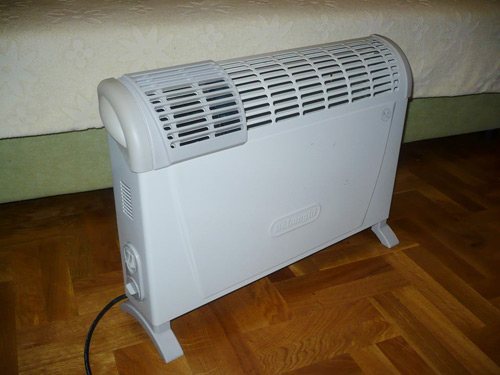

Convector heater
The absence of special manipulations during installation is compensated for by the relatively high energy consumption, as well as complete dependence on it. By the way, there is some benefit here. In the event of a power failure, one medium-power gasoline (diesel) generator is enough to start at least one convector. This will already be enough for the building to retain heat, the pipeline does not freeze.
When the house needs additional heating, the convector will be a smart and rational solution. Heaters are compact, easy to install or move (for some types). The functionality of most devices allows you to adjust the power and intensity of heating.
Note! It is not recommended to save on the number of devices. Insufficient heating of concrete structures leads to the formation of excessive moisture and mold. Naturally, it all depends on the climate, but this problem is quite common for owners of this type of device.
The appearance of heating devices is rarely taken into account, but in the case of this type of heaters, this moment cannot be ignored. In the assortment of stores you can find a variety of versatile models, stylish convectors of the middle price category. But you can create an individual order when the manufacturer puts an image on the panel, or covers it with natural stone. The latter option is the most expensive, but suitable for those who subtly calculate and plan the design of premises.
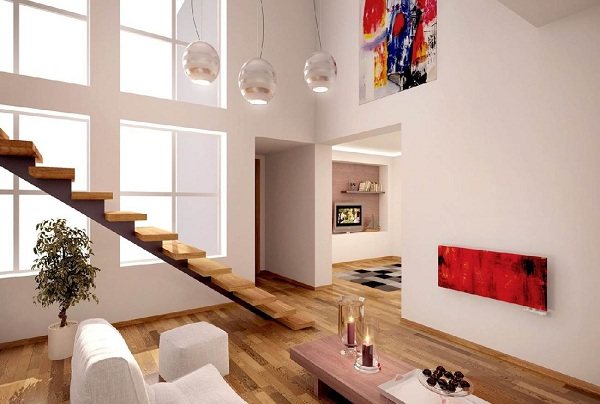

Features of electric boilers
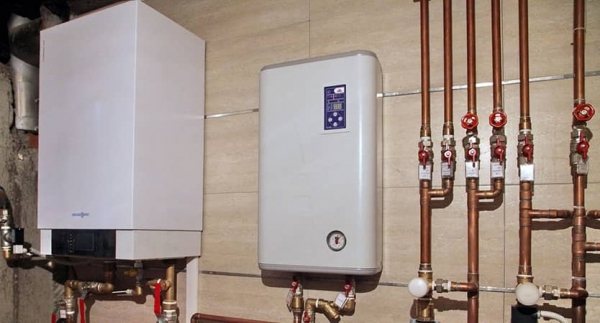

An electric boiler is a heating device that is capable of heating a large area, due to the provision of heat supply from a central heating device to the actual heat sources. That is, a heating device is located inside the boiler itself. It heats the water, and the water passes through the laid pipelines to the radiators (batteries), which are the sources of heating.
The peculiarities of electric boilers are that they:
- Do not dry the air. Does not burn oxygen, and does not create the sensation of being burned in air.
- You can pick up double-circuit models that can not only heat the room, but also provide hot water supply.
- Unlike single heaters, an electric boiler can effectively heat a fairly large area. After all, it is the center, the distributor of heat supply.
The price will also depend on the complexity of the installation itself. It can be noted that low-power simple installations are quite cheap.
Depending on the needs and the room where it will be used, you can choose a simple or more advanced version, in particular, boilers are distinguished:
Equipped with heating element and trigger for commissioning. In addition to standard installations, they are equipped with temperature control sensors. Advanced options include a remote control system.
Heating with electric convectors
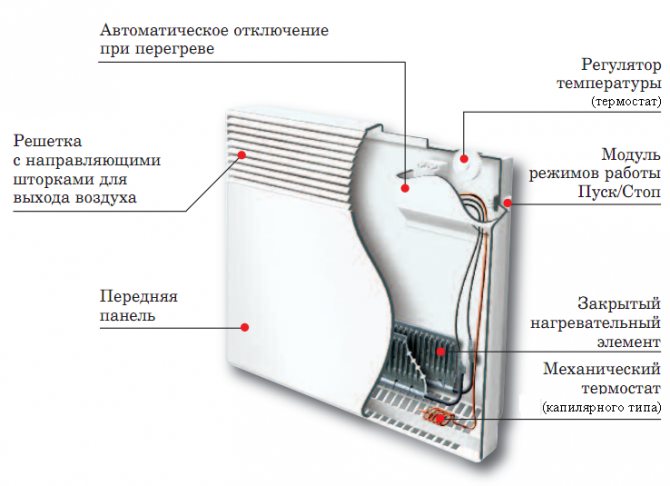

The device of an electric convector is not much more complicated than an electric boiler.
Electric boiler or convectors - the choice is complicated by many factors. We have already talked about the features of water heating with electric boilers, now it's time to talk about heating with electric convectors. These devices are fairly simple heating devices that work on the principle of natural convection. They consist of the following parts:
- Air heating elements - provide air heating;
- Control systems - provide temperature control and perform other useful functions (for example, work according to a given program or in the "anti-freeze" mode);
- Housing with slots for cold air intake and hot air outlet.
In this way, this is extremely simple but functional equipment.
Some electric convectors have additional modules. For example, there are commercially available samples with built-in humidifiers.
The principle of operation of electric convectors is very simple. When they are turned on, active heating of the air surrounding the heating element begins. As it heats up, it rises up and leaves the device body through the upper slotted holes. In its place, cold air masses immediately enter, sucked in through the lower slots. Hot air flows out by gravity - this is how natural convection works.
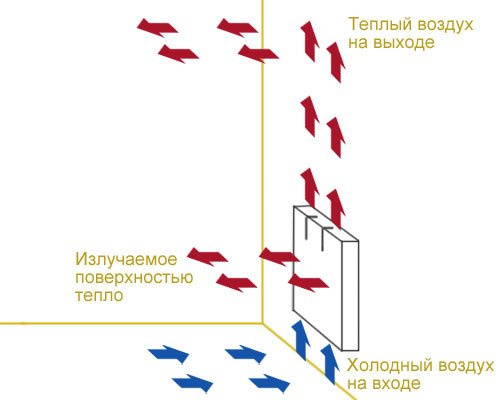

The air heated by the convector rises to the top and gradually heats up the entire room.
In 1-2 hours after switching on, electric convectors completely warm up the air in the premises. The process is long, but after reaching the set temperature, the heat will remain for a long time. Heating is monitored by automation, which maintains the set temperature. Moreover, the automation in electric convectors can be of two types:
- Mechanical - here is the simplest bimetallic element that enables the devices to be turned on or off. It is not possible to set the exact temperature here;
- Electronic - an electronic sensor monitors the heating process, and the temperature can be adjusted with an accuracy of 0.5-1 degrees, which provides an economical mode of operation. Some advanced electric convectors are even equipped with thermometers with digital indication of the current air temperature.
The use of electronic control makes it possible to achieve an economy of up to 10% compared to devices with mechanical control.
Let's take a look at the main advantages of electric convectors. The main advantage is the extremely simple installation of the entire heating system - you just need to hang the equipment under windows or on blank walls, and then connect it to an electrical outlet. That is, users get rid of the tedious laying of pipes and connecting heating batteries to them. Also, there is no coolant here.
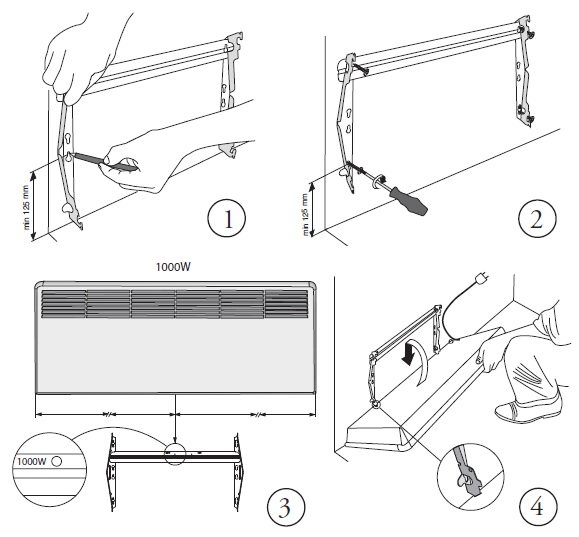

Installation of the convector is very simple, the most difficult thing is to screw the fasteners to the wall according to the level.
Another advantage is easy separate temperature control in the rooms. For example, if a room is not in use, you can close the door in it and turn off the electric convectors installed here. In classic water heating, separate adjustment is also possible, but pipes with a hot coolant will still remain here.
Electric convectors are good for their safety. Their back walls practically do not heat up, therefore the equipment can be mounted close to the walls of the household... The temperature of the front panel does not exceed +90 degrees - an accidental touch will be unpleasant, but it will not lead to a burn. In addition, electric convectors do not burn oxygen and do not change the chemical composition of the air.
There are also certain disadvantages, the first of which is the high consumption of electricity. We have already said that electric heating is expensive, and electric convectors consume about the same as conventional hot water heating. However, some efficiency here is provided by the use of precise electronic control and the absence of a coolant.
At the initial stage of the equipment operation, electricity is wasted almost in vain, since the heating of electric convectors is quite long, and consumption goes "to the fullest".
The next drawback is that if gas appears in the settlement, then it will take a decent amount of money to re-equip a house for water heating with a gas boiler... If there were already pipes and radiators, it would only be necessary to buy a boiler and connect it to the system. In the case of electric convectors, one more problem will have to be solved - where to put the equipment that has become unnecessary.
Also, among the shortcomings, you can include the fact that many people do not like the feeling of burnt air, since it does not cool immediately - its temperature can be high near electric convectors. When using an electric boiler, there will be no such effect.
Boundary rule 4 and 6
In order to determine the best way to heat the house, it will be very important to know the size of the house, or rather, the number of necessary heating devices around the entire perimeter of the house. Experts were able to establish fairly clear boundaries
If the house is very small and only needs 4 heating devices, then there is no point in installing an electric boiler and a radiator network. In such a house it will be much easier and easier to install electric convectors. If the house is large enough and already needs 6 heating devices, then experts definitely recommend purchasing an electric boiler. A rather difficult situation arises if 5 heating devices are enough for your house. Indeed, in this case, you can choose for yourself both the one and the other option.
conclusions
Thus, it is impossible to unequivocally answer which equipment is better to install in the house - convectors or an electric boiler with radiators. In each case, the choice will depend on the circumstances. For example, if in the near future it is possible to lay a gas pipeline near a private house, then the arrangement of water heating with an electric boiler looks quite expedient. After connecting to the gas main, it will be enough just to replace the boiler. If gas will not appear in your region in the foreseeable future, you can get by with electric convectors - the installation will be much cheaper.
In terms of energy costs, heating will be very expensive in both cases. You can minimize costs if you install electric convectors with electronic automation. This will reduce costs by 5-10%. In both cases, the power of the equipment is selected based on the accepted norms - 1 kW of energy per 10 m2 of area.
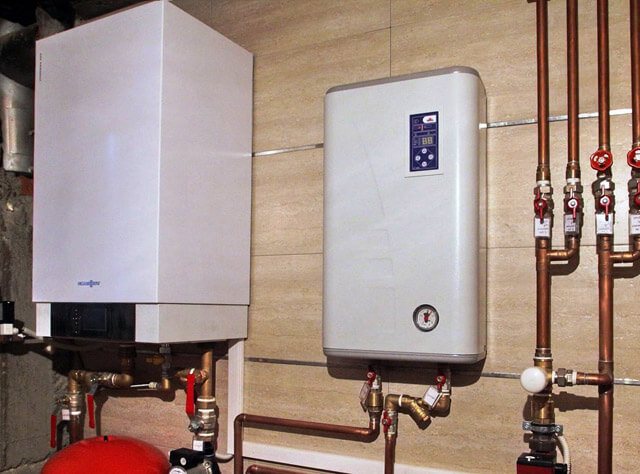

Of course, the size and type of the room should be taken into account. So, in a small cottage, you can get by with the installation of convectors without investing time, effort and money in expensive water heating. If you live in a large house, then water heating with an electric boiler will create more comfortable living conditions. In addition, it can always be refitted with a gas boiler at the earliest opportunity.
Features of electric boilers
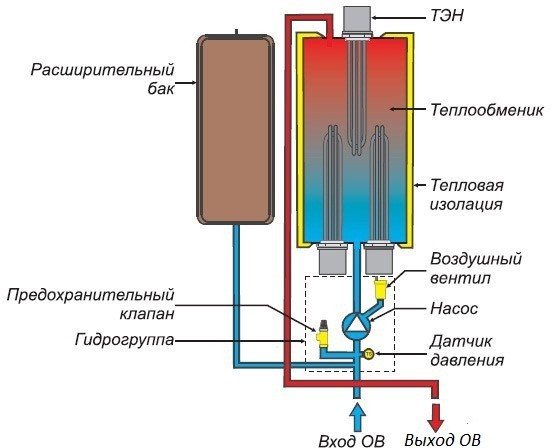

Electric boiler operation diagram.
Until recently, there was an opinion that an electric boiler is suitable exclusively for heating oversized premises. But this opinion turned out to be wrong. Today, the market in a wide variety is represented by electric boilers, the power of which ranges from 40 to 100 kW. Such equipment will easily be able to cope with the heating of a room, which has an area of up to 1000 m². In addition, an electric boiler is able to compete in a number of advantages with an oil boiler.
However, when choosing equipment, it is worth considering not only power, but also many other factors. An electric boiler will allow you to save money, because when purchasing it, you will need to pay only for the boiler itself, unlike, for example, liquid fuel equipment, where you will have to pay extra for a mounted burner and a container. You can save money not only during purchase, but also during installation. Thus, the cost of installation work will be minimal.During operation, the electric boiler is also ready to show itself very positively, since it will not need constant maintenance and mandatory cleaning. The electric boiler will not need
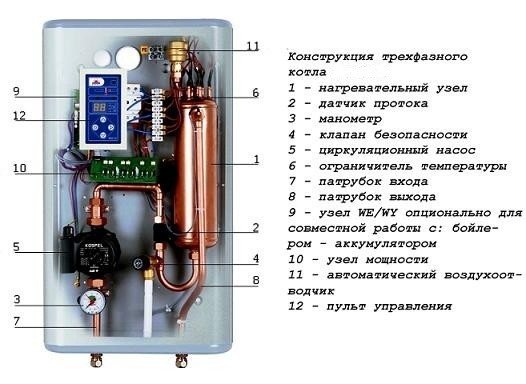

The design of a three-phase electric boiler.
fuel costs. Its use allows you to comply with all environmental requirements, and during operation it does not emit extraneous odors.
However, such devices still have drawbacks, the main thing is that when using them, it is not possible to allocate a sufficient amount of electricity power, which is necessary for operation, in addition, interruptions in the operation of power grids can affect the operation. But in case of power outages, the electric boiler can be used in parallel in the heating system with other types of boilers. A similar heating system has gained popularity in the recent period.
Installation of an electric convector
Heating convector heaters are easy to install. The body of the device reaches low temperatures, which allows you to mount the device in any place, without fear of spoiling the decorative finish and interior. Electric convectors are divided into types according to the installation method:
- universal;
- wall-mounted;
- floor;
- built-in.
Universal convector heaters are fixed to the wall with brackets or installed on the floor. Legs or casters are included. The universal installation method allows you to change the location of the heater. The convector can be fastened by hand.
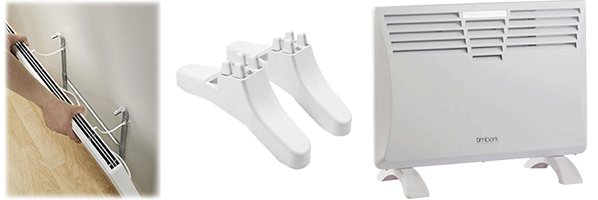

Wall-mounted models are installed in the same way as universal ones, with the exception of the configuration, which does not provide additional feet for installation on the floor. But if the design allows, it is quite possible to purchase them separately. You can mount the device next to decorative elements or on delicate decorative finishes, but it should be borne in mind that warm air moves vertically from the device. It is not recommended to place flowers, pet houses or any objects over it that may overheat or block the flow of warm air masses.
Built-in models of convector heaters are installed in a special niche in the floor at least 20 cm deep. The upper part of the heater is covered with a grill. This type is stationary, the device cannot be moved. As a rule, built-in heaters are used for non-residential premises - exhibition halls or shopping centers, where the convector creates a thermal curtain. In private homes, such devices are used in cases where the walls are completely made of glass. There are also models that can be built into the windowsill.
Heating elements of electric boilers
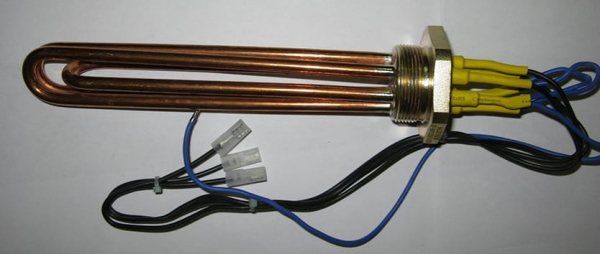

All electric boilers can be separated according to the type of heating element. Each of them has its own operating principle and features. And so, such boilers can contain:
TENA is a well-known and widespread method of heating water. The tubular heating element heats up the water, which moves and provides uninterrupted heat supply.
However, it has certain disadvantages. TENA often suffers from limescale from heating water and high temperatures. Because of this, it fails. This is solved by replacing the heating element. But it can still create discomfort during the heating season.
Electric convectors - their advantages and disadvantages
In comparison with boilers, the advantages of these devices are insignificant, but they are quite significant:
- Electricity consumption. When equipping a large number of rooms, the total power of the devices will not exceed 24 kW / h. If 9-11 rooms are equipped with convectors, this figure will be about half the energy required by the boiler. Even if you add the cost of hot water supply. Even in economy mode, an electric boiler consumes about 15 kW / h. According to this indicator, the advantage is obvious.
- No large installation costs are required. The design is very simple. The plug from the heater is connected to the socket and the system works. It does not require piping, installation and piping of the boiler.
- If the electric boiler fails, the heating will not be able to work throughout the building. When working with heaters, heating of only one room will stop. Such a scheme is more independent of damage to one of its parts.
- Each person can equip a house with a heating system. But this is a rather controversial advantage.
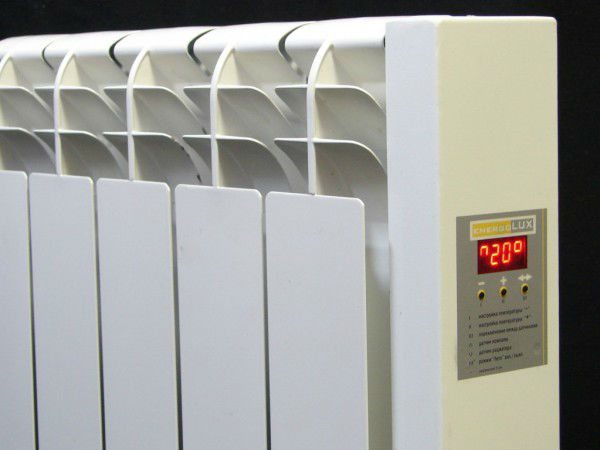

The above are the main benefits. If you use an electric convector, then the load on the network decreases, different costs. But is this really true, is it really the question of electric boilers or convectors, the advantage over wall appliances. Take your time to jump to conclusions.
Yes, the installation of devices does not require qualifications, but it should be noted that for normal operation it will be necessary to replace the wiring and install a large number of outlets and protective devices. Such work will require significant investment. Especially when reinforcing the entrance to the building. Now this method no longer looks so economical.
This scheme works well and is simple. But here comes the problem of dry air in the room. To solve it, you will need to spend additional funds.
Output. No one can give a definite answer, an electric boiler or convectors are better for creating heat.
Before determining the method, you need to know the timing of supplying natural gas to the house. If the issue of gas supply to the settlement is soon resolved, the best solution would be to lay pipelines in the rooms and install an electric boiler. Good, better option. The boiler can be easily replaced with a gas one, and the piping system will be ready. Even if it takes several years before, it is better to be ready in advance.
In the absence of prospects for the nearest gasification, it is better to use a more economical method of heating with convectors. But even in this case, the answer is ambiguous. Installing a double-circuit electric boiler, equipping the system with a heat accumulator and equipping the house with an electric meter for the night rate can save finances.
To this it remains to add, the operation of the convectors is not automated, therefore, the adjustment will have to be carried out, going through the entire building.

